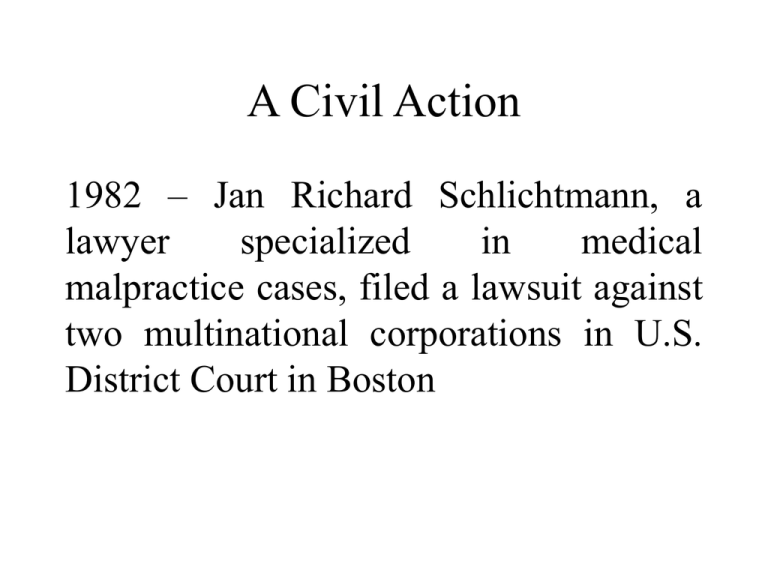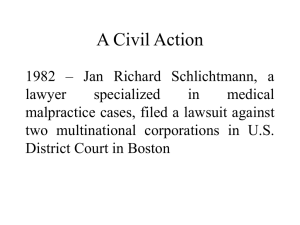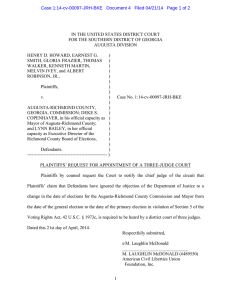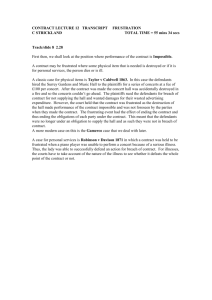A Civil Action
advertisement

A Civil Action 1982 – Jan Richard Schlichtmann, a lawyer specialized in medical malpractice cases, filed a lawsuit against two multinational corporations in U.S. District Court in Boston Plaintiffs • 6 Woburn families, all of whom had a child who had died of leukemia or who was being treated for the illness. • The case grew to involve eight families Defendants W.R. Grace & Company, which owned and operated the Cryovac Division manufacturing plant at 369 Washington Street, about 2.400 feet northeast of the wells. The Cryovac plant manufactured equipment for the food packaging industry and used solvents to clean and cool tools, cut grease and dilute paint Beatrice Foods Company, which, in 978, purchased the John Riley Company Tannery, 228 Salem Street, and adjacent 15-acre undeveloped property, from John Riley Jr, and sold them back to him in 1983. As a stipulation of Beatrice’s agreement to resell the tannery to Riley in 1983, Beatrice retained legal liability for environmental matters. Northeast of the tannery was the 15 acre parcel, undeveloped land that the tannery had purchased in 1950s for its water supply. Schlichtmann charged that the groundwater beneath the 15 acres had become contaminated through activities at the tannery and by the dumping of chemicals on the surface of the 15 acres. UniFirst Corporation, which operated and industrial dry-cleaaning business at 15 Olympia Avenue, about 200 feet north of wells G and H. UniFirst used PCE as part of its business and tests on UniFirst Property revealed large quantities of PCE in the soil and groundwater. The complaint The site and surroundings •Woburn is a city of 35.000 located twelve miles north of Boston. Until 1979 the city’s entire municipal water supply was provided by a number of groundwater wells located within the city limits. Two wells of particular relevance in this proceeding, city Wells G and H were opened in East Woburn in 1964 and 1966, respectively. Wells G and H are located just off the banks of the Aberjona river Contaminated water wells In May 1979, after water had been drawn from these wells over the course of fifteen years, wells G and H were tested for volatile organic contamination. They were found to have hazardous levels of contaminants and were immediately shut down. In tests for contaminants in 1979, and subsequent tests in 1980 and 1981, wells G and H showed consistently high concentrations of two contaminants: trichloroethylene was identified in concentrations as high as 400 ppb (parts per billion) and tetrachloroethylene was found at 43 ppb Trichloroethylene TCE is a potent central nervous system depressant and can cause several neurological symptoms such as dizziness, loss of appetite and loss of motor coordination. It produces liver damage at certain exposure levels and causes cell mutations and cancer Tetrachloroethylene Tetracholoethylene exhibits adverse effects on the central nervous system and is also a carcinogen. Its effects include depression, nausea, liver dysfunction, chronic bone marrow depression and leukemia Causes of action Defendants owe plaintiffs and plaintiffs’ descendents a duty to refrain from action which causes plaintiffs and plaintiffs’ descendents to be unreasonably exposed to chemicals which can cause personal injury, economic harm, illness, or which increases the risk of contracting illnesses. The chemicals described above are ultrahazardous substances, and defendants knew or should have known of the dangerous nature of the substances. Defendants are liable for all harm caused to plaintiffs and plaintiffs’ descendents in the manufacture, use, control, and/or disposal of such chemicals Defendants failed to exercise due care in the manufacture, use, control, and/or disposal of such chemicals. Defendants’ failure to exercise such care caused plaintiffs and plaintiffs’ descendents to suffer in mind and body, to contract illness and to suffer the increased risk of contracting illness in the future, emotional distress, and mental anguish, and to suffer the loss of use and enjoyment of the property, and economic and financial harm Wrongful death Defendants’ conduct constituted gross negligence. Defendants’ failure to exercise such care and gross negligence caused plaintiffs’ descendents to die. Defendants’ failure to exercise such care and gross negligence caused plaintiffs who are entitled to receive such damage, to be deprived of the descendents’ s reasonably expected net income, services, protection, care, assistance, society, companionship, comfort, guidance, counsel and advice. Conscious pain and suffering Defendant’s failure to exercise such care caused plaintiffs’ descendents to consciously suffer pain and mental anguish prior to death Nuisance The contamination in the ground water from which plaintiffs received their water and which was caused by defendants’ actions constitutes a nuisance which is inimical to plaintiffs’ health and restricts their access to and use of the ground water flowing beneath East Woburn and beneath their property. The continued disposal of hazardous substances on the ground and the continued presence of hazardous substances in the soil of defendants’ property in East Woburn constitutes a further threat to the ground water and is a nuisance which is inimical to plaintiffs’ health and restricts their access to and use of the ground water flowing beneath East Woburn and beneath their property. RELIEF Wherefore, plaintiffs pray that court, upon trial and determination of their causes of action, award the following relief: •Compensation as provided by law; •Order defendants to halt all further disposal of hazardous substances on the ground of their property in East Woburn and to remove from the soil on/or adjacent to their property in East Woburn all hazardous substances placed there by them •Order defendants to provide appropriate methods to remove all contamination from the ground water flowing beneath East Woburn and plaintiff’ property and return the ground water to the condition it would be in but for the contamination.



